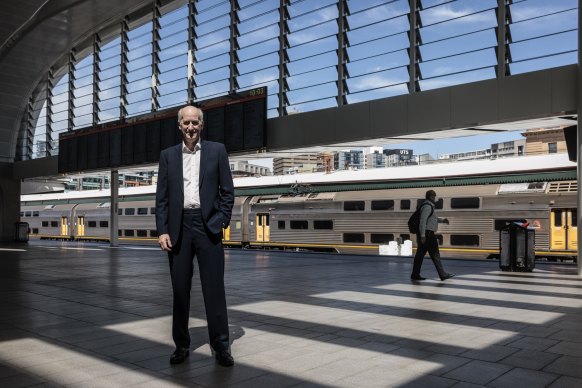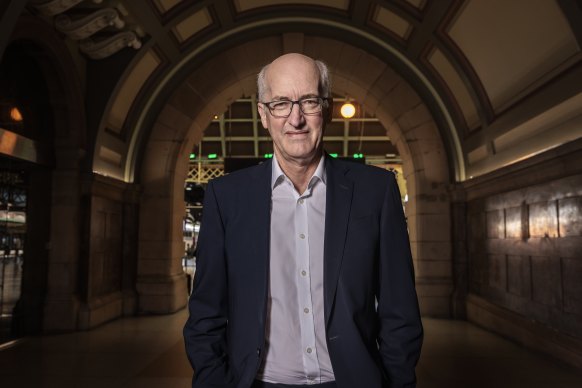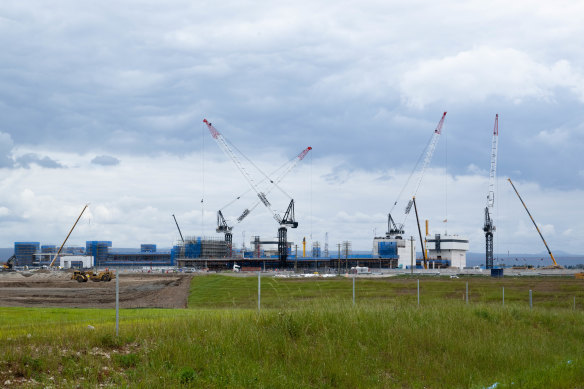High-speed Sydney to Melbourne rail plan ‘will never work’: infrastructure tsar - SMH - Michael Koziol Dec 8, 2022 626 Comments
One of the world’s top infrastructure tsars says planners and the prime minister
should forget high-speed rail between the eastern capitals and focus on faster
trains around Sydney and other sprawling urban areas.
Sir David Higgins – the Australian-born chairman of London’s Gatwick Airport and former chair of the UK’s high-speed rail authority – predicted the Sydney to Melbourne route would “never really work” as high-speed rail.
Sir David Higgins, chairman of Gatwick Airport, said Sydney should fix its slow suburban and regional trains first.
“It’s a logical route for airfares. High-speed rail doesn’t really make sense commercially if it’s more than two hours,” he told the Herald and The Age, adding the Eurostar was successful because the London to Paris journey was about two hours.
Higgins – who joined Sydney Airport’s board earlier this year – will address the Western Sydney Leadership Dialogue’s Boomtown conference on Thursday, as will federal Infrastructure Minister Catherine King, who alongside Prime Minister Anthony Albanese is a key fast rail proponent. NSW Premier, Dominic Perrottet, will also speak.
Last month the federal government passed legislation to create a High-Speed Rail Authority that will advance plans which have been discussed for four decades but never realised.
As a first step, the Commonwealth is co-funding a $1 billion project with the NSW government to upgrade rail infrastructure north of Sydney, which they say will pave the way for eventual high-speed travel between Sydney, the Central Coast and Newcastle.
Sir David Higgins at Central Station
“That’s the most commercially viable bit to start with,” King said in September. “[That’s] really where the proof of concept is.”
King said the project’s “time had come” and noted high-speed rail was replacing domestic air travel in other countries – this week the European Commission approved France’s ban on short-haul domestic flights if there is a train that takes less than 2.5 hours.
Higgins said Australia was better off maximising train speeds within big population zones such as Campbelltown, Penrith and Liverpool to Sydney CBD, or between Brisbane and the Gold Coast.
Public transport Years late, NSW’s new trains to finally start carrying passengers
While Sydney trains tend to “trundle along”, London has suburban and regional trains that reach speeds of 160 kilometres an hour, such as ThamesLink between Bedford and Brighton, or higher.
“It would be interesting to see what more you could get out of [your] existing network,” he said. Those investments could later become full-scale high-speed rail from Sydney to Goulburn and Canberra, Higgins said, but “focus on getting your urban areas to work first”.
NSW Cities and Infrastructure Minister Rob Stokes said the state government would slash travel times between Sydney and Parramatta to 20 minutes with the forthcoming Metro West line.
The Commonwealth had “expressed a lot of enthusiasm for high-speed rail and we’re waiting for clear signals from them about what their plans are”, Stokes said.
In 2018, months before the 2019 election, the NSW government identified four potential fast-rail corridors; from Sydney to Newcastle, Canberra, Orange/Parkes and Nowra. Then premier Gladys Berejiklian ordered a further review by expert Andrew McNaughton, but it was never released publicly.
‘You have to show people that in the end they are going to get some reward for density and disruption.’ Gatwick Airport chairman, David Higgins
The Greater Cities Commission also recently unveiled its draft “six cities” vision, a key pillar of which is better connectivity between Newcastle and the Central Coast, Illawarra and Sydney.
Higgins, who lives in London but returns to Sydney often, will use his speech on Thursday to tell policymakers the masses of new infrastructure in the city’s west must serve a social purpose.
“My worry is that here it seems to be growth by opportunity,” he said. “It’s a case of: here’s a new railway station, let’s pop up a 50-storey high rise. [But] how many people are going to live there, where’s their community, where are their high streets, where are their parks, where do they get recreational facilities?
Construction continues on the Western Sydney Airport in Badgerys Creek, Sydney
Higgins said governments and planners didn’t pay enough attention to parks, citing Bicentennial Park at Olympic Park as a green space that should play a much greater role as the “lungs” for that part of Sydney. Higgins was also chief executive of London’s 2012 Olympics delivery authority.
He criticised Australia’s reluctance to finance major public infrastructure by taxing nearby landowners who benefit from increased land values, a system usually called “value capture”.
“It’s an ideological problem, which is: you’re taking away the right of someone to get a windfall profit by getting a planning gain,” he said. For example, high-speed rail would drastically increase property values in towns it passed through.
Higgins welcomed the additional flight capacity and competition from the forthcoming Western Sydney Airport, which is due to open in 2026 after decades of dithering.
“It’s good it has finally developed,” he said. “The biggest thing we could do is get more direct flights to the growing markets of Asia ... hopefully you get more diversity of carriers.”


